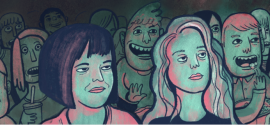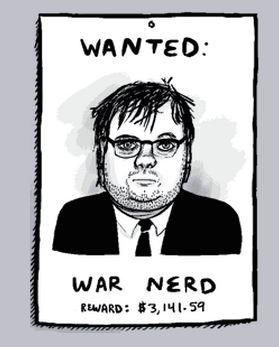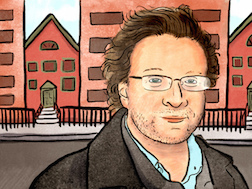On the walls of ugly sleeping quarters of Moscow, of all those Tchertanovos, Khimki-Khovrinos Belyaevos and Orekhovos, on the old fences here and there still possible to find the faded away posters. Young attractive woman, wearing some strange-looking, museum Egyptian-style head decoration. With a one hand she is squeezing some sort of scepter. Maria Davy Christos.
Hundreds of thousands followers all over Russia and Ukraine were worshiping that modern Goddess from 1990, when she and her sect “White Brotherhood” suddenly appeared in confused and mentally disturbed post-Soviet Russia. Maria Krivonogova-young school-teacher, her brother and her husband-hastily responded to the silent demand of the masses: “Give us an object of adoration, as we are without any.” So Maria and hers have produced some religion made of mixture of poorly understood Christianity with a poorly understood Khrishna-ism. Maria-Davy brought to hysteria Russia and Ukrainian masses until the day in 1992 when she was arrested with a tens of her followers, during an attempt to occupy the Kiev’s Kievo-Pecherski Cathedral: Arrested, she undergone trial and was condemned to eight years of imprisonment.
Story of school-teacher Maria Krivonogova, becoming Maria Davy Christos, The Goddess, is sentimental and tender one. It proves that today as a many centuries ago it is still possible to create a religion.
As a matter of fact, the cult of “Bogoroditsa” (or to be exact, “Ones that gived birth to the God”) is strong in Russian Orthodox Church, but “Bogoro-ditsa” is also a main figure of Russian cults. Thus, the sect of “Khlisti” (or whippers), [few centuries old and flourishing during the years before the Revolution of 1917] was worshipping carefully chosen “Bogoro-ditsa.” Usually, “Bogoroditsa” was a young girl.
The so called “radenya” (joyous gatherings) could be compared to the ancient mysteries, were in fact collective orgies. They started from ritual dancing, self-flagellation, undressing. Then, with a rising rhythm and intensity of a dance, they would culminate in copulation of a group with a “Bogoroditsa.” Diametrically opposite approach was practiced by the sect of “skoptsi.” The right to enter the sect of “skoptsi” was gained and preceded by macabre ritual of castration: “malaya pechat” (small seal)-when the balls of man were cutted out. Some more demanding natures were not satisfied by degree of asceticism and renunciation of the world and more complicated operation was required: the complete elimination of genitals: or “belaya pechat” (white seal). The sect of “skoptsi” gained in 19th century popularity among the Russian aristocracy. The head butler to Alexander I, Count Elanski, “Skopets” himself, even went so far as to propose to Tsar a bizarre project of making entire Russian administration members of sect “skoptsi.” On the ground that “skoptsi” is natural aristocracy of Russia, they are free of worldly emotions. Alexander I was outraged and sent Elanski in eXile, but famous aristocratic salon of countess “Tatarinova” was infected with a “Khlisti,” “Skoptsi,” “flagellants” and others. Decembrist revolutionaires and Pushkin himself frequented “Tatarinova.” According to some sources, Pushkin was flagellant.
During the reign of a Nicolas I, when it was dangerous even to declare oneself of other religion than Russian Orthodox, according to the official statistic, one third of Russians were members of heretical cults. Most of them were “staroobriadtsi” (Old Believers), those who didn’t follow the rites of reformed Russian church of Patriarch Nikon. Nikon’s reform of 1666 divided the church. The Old Believers were making sign of cross with a two fingers, the new reformed orthodoxes-with three fingers. But real differences run much deeper. The only Refor-mation of a Russian church done by Nikon was done in order to modernize it. Resistance to Nikon’s reform was strong and repressions on them-savage. “Raskolniki” (breachers), as were called “Old Believers,” threw themselves in a fire with babies, entire families perished. Some “Old Believers” escaped to Siberia, some to America, or even to China. The spiritual leader of Old Believers proto-pope Avacum was burned.
The Old Believers didn’t forgive it to Romanov’s dynasty. Many of them joined Bolshevik’s centuries after. The reason why capitalist Savva Morozov helped Bolshevik’s party in financing was not a whim, but his inherent hatred for Romanov’s dynasty and its Nikonian church. 1917 October Revolution was saluted by many Old Believers. They were enchanted. As three fingers church was regarded as a sacrilegious, Old Believers saluted antichurch activity of Bolsheviks.
This article was published in Issue #5 of The eXile, April 1997.
Read more: cults, eXile Classic, exile issue 5, limonov, Russia, russian cults, Edward Limonov, eXile Classic


Got something to say to us? Then send us a letter.
Want us to stick around? Donate to The eXiled.
Twitter twerps can follow us at twitter.com/exiledonline
















Leave a Comment
(Open to all. Comments can and will be censored at whim and without warning.)
Subscribe to the comments via RSS Feed